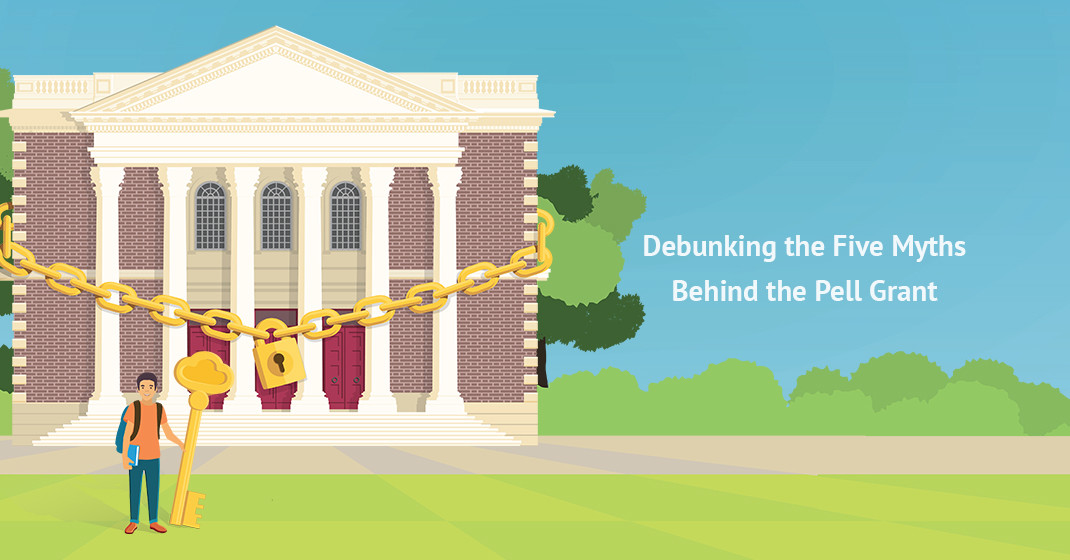
Debunking the Five Myths Behind the Pell Grant
While college enrollment continues to climb, it has grown the least for low-income students. The Pell Grant was created to open the door to college for low-income students, but we find that qualified Pell Grant recipients are being denied the opportunity of an elite college education. Some argue these students are not qualified or that the institution can’t afford to enroll these recipients. But we find these arguments to be long-held myths. Let me explain why.
Myth 1: Most qualified Pell Grant recipients would struggle at selective colleges
Fact: Most high-scoring Pell Grant recipients would do very well at selective colleges. In fact, Pell Grant recipients graduate at almost exactly the same rate as all students at selective colleges. Seventy-eight percent of Pell recipients who attend selective colleges and universities graduate, while their chances to complete diminishes to 48 percent at open-access colleges. About 150,000 Pell Grant recipients have SAT/ACT scores above the median test score for students at selective colleges (1120 or higher), yet more than half of those Pell students do not attend selective universities.
Myth 2: Colleges can’t afford to enroll more Pell Grant recipients
Fact: Many selective universities have multi-million dollar surpluses. Sixty-nine of the most selective colleges ran average annual budget surpluses of $139 million over the last four years but admitted less than 20 percent Pell Grant recipients. While freeing up more money for need-based aid would require strategic budget reallocations, the size of these budget surpluses indicates that these colleges have more than enough resources to comply.
Myth 3: Pell Grant recipients can be found in large numbers at just about any college
Fact: Pell Grant recipients indeed make up 50 percent of the student body at more than half of all U.S. colleges and universities. Meanwhile, the majority of the most selective colleges have fewer than 20 percent Pell Grant recipients. Only about a dozen of the most selective colleges in the U.S. enroll at least 20 percent Pell Grant recipients. The University of California-Los Angeles and the University of California-Berkeley are among those with the highest percentage of undergraduates who receive Pell Grants. The selective colleges and universities with the smallest percentage of Pell recipients are primarily private institutions. But the path to resolve this is not such a steep climb. Only about six percent of American colleges fall short of the the 20 percent Pell Grant threshold. That means that out of the more than 5,500 colleges and universities, only about 72,000 Pell students would have to be admitted to only 346 colleges and universities to meet the 20 percent threshold.
Myth 4: Pell Grants are relatively uncommon
Fact: Pell Grants are very common—two out of five undergraduate students receives a Pell Grant, totaling about 8 million students per year. They are also the most widely used form of federal financial aid.
Myth 5: Pell Grants cover a majority of college costs
Fact: When the Pell Grant was originally created in 1972, it covered a majority of the cost to attend college. This is not the case today. The average Pell Grant award is $3,724 and the maximum Pell Grant is $5,815. The average cost of college today is $22,432. Keep in mind that nearly three quarters of Pell Grant recipients come from families making less than $30,000 a year. So it’s no surprise that a lot of Pell Grant recipients opt to go to public two-year colleges because the average cost is only $9,939. If selective colleges don’t offer a lot more financial aid then the Pell Grant, it’s clear that the opportunity for an elite college education with the most favorable outcomes is fleeting for low-income students.
In the end, you can see that higher education is more and more stratified by class. Mandating a certain percentage of Pell students at all colleges could help equalize opportunity in higher education. Especially in a day and age when access to education determines class and labor market outcomes. If we give low-income students better access to selective colleges or the kinds of resources those colleges provide, their graduation rates would almost double. And that’s an outcome we should all strive for.
Read more in the full report, The 20% Solution: Selective Colleges Can Afford to Admit More Pell Grant Recipients.
Follow Georgetown University Center on Education and the Workforce on Twitter, (@GeorgetownCEW), LinkedIn, and Facebook.
Dr. Carnevale is Director and Research Professor of the Georgetown University Center on Education and the Workforce, an independent, nonprofit research and policy institute affiliated with the Georgetown McCourt School of Public Policy that studies the link between education, career qualifications, and workforce demands.
Owner @ Making College Worth It | Financial Aid Optimization
6yGeorgetown University only have 13% of undergrads receiving the Pell... Hmmm...